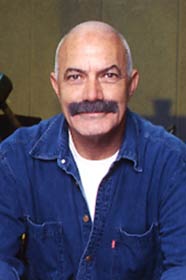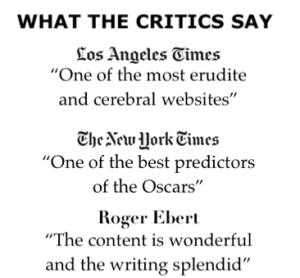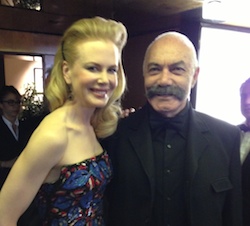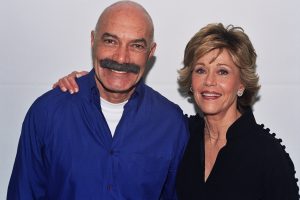




There was an inverse proportion between our lack of money and the abundance of spirit in our crew and cast. Everything was done simply, not only because we didn’t have the budget but also because, artistically, everything needed to be honest, direct, and clear, from the rawness and vulnerability of our actors to the presence of the natural environment.
–James Schamus, producer
Ang Lee understands characters’ emotions completely. Nothing escapes his notice, and he uses every piece of the frame to tell his story.
Marit Allen
Ang Lee has made an epic American love story, based on the short story by Pulitzer Prize-winning author Annie Proulx and adapted for the screen by the team of Pulitzer Prize-winning author Larry McMurtry and Diana Ossana. Set against the sweeping vistas of Wyoming and Texas, the film tells the story of two young men, a ranch-hand and a rodeo cowboy, who meet in the summer of 1963, and unexpectedly forge a lifelong connection, one whose complications, joys, and tragedies provide a testament to the power of love.
Principal photography on “Brokeback Mountain” began in Alberta, Canada, in May 2004 and was completed in August. Post-production was finished in the spring of 2005, marking the culmination of the story’s eight-year journey to the screen.
Landscape, the place where they grow up, is what forms the characters. They can move away and live in other places, but they’re always drawn back, at least emotionally, to the place where they’re from. Shooting locations in the region included the Canadian Rockies, Cowley, Fort MacLeod, and Calgary. Members of the Calgary Gay Rodeo Association advised and consulted with the production, and also appear in several sequences.
The team didn’t have good luck with the weather, what with sleet, hailstorms, and it was always cold, and mountains are not controllable either. Logistically, it was a stretch, and the budget was modest. This was an independent film, and the least expensive one Ang Lee has made since “Eat Drink Man Woman,” but sufficient to make his vision come true.
Visual Approach
Allen: To me, “Brokeback Mountain” has the look of a classic Western. And the Western is one of the last great romances; the loneliness and the strength of these men who embody hard work and integrity. Ang wanted to reflect the reality of the story, the places, the people and their economic situations. Ang, cinematographer Rodrigo Prieto and myself all studied Richard Avedon’s book Photographs of the American West. He took photographs in the 1960s, and revisited the subjects twenty years later. There was a photograph in the Avedon book that we took as the template for Alma. Michelle Williams understood it, and embraced it immediately.
Ang Lee: Rodrigo is a great cinematographer. He’s very quick. I love his work from Alejandro Gonzalez Inarritu’s movies; also from Alejandro’s crew, I took composer Gustavo Santaolalla. The movie is poignant and stark, so we needed sparse music here and there, and his score fits perfectly. Each time we could not afford a song, he would write us one.
Realistic Setting
Becker: Right from the start, Ang made it clear that he wanted “Brokeback Mountain” to be in a realistic setting in order for the audience to believe in the characters. But you have to imagine a way to create reality on film in a way that’s different from real life. In general, I try to let the sets be a naturalistic background to the actors. That’s one of the ways in which you have to try to transform what reality is into something that becomes the reality of the movie.
It’s annoying to me when I see a “period movie,” and there’s a Life Magazine with John Kennedy on the cover, like “Here we are, it’s 1962.” When I started working on this film and hired my crew, I told them that I wanted to find subtle ways to show the year or the period that we’re in.
Color Palette
Becker: When I met with Ang the first time, we talked about making the color palette slightly de-saturated and somewhat subdued for most of the movie. Brokeback Mountain represents a freedom that Ennis and Jack don’t feel in their towns.
Ang and I, and Rodrigo, talked about how the towns would be a strong contrast to the mountains, colorless and cluttered. We didn’t have the resources to build a huge amount of the sets. The biggest challenge was finding the right locations. During prep, when we found an apartment and a diner that I could transform into the places that I had envisioned in my head and discussed with Ang, that was a great feeling.
I did an enormous amount of research, both into the periods and the locales. The 1967 supermarket sequence, for example, was a very specific process; researching what products were available, what the labels looked like, what the advertising looked like, what the supermarket looked like.
I looked at imagery of small towns. One thing that struck me, which Ang and I discussed early on, was that although the movie takes place mostly in the 1960s and 1970s, the towns still looked like they could be in earlier decades. We went to Wyoming and Texas to do some research and, even now, so much detail and architecture is left over from pre-World War II. Change happened very, very slowly in small towns in the West.
The Campsites
Becker: We found documentary references for the 1960s campsites. Those haven’t changed very much; they look pretty much the same today as they did 40 years ago. Then, with the later 1970s and 1980s campsites, we wanted to show the social and economic changes for the characters. Jack becomes fairly wealthy during the course of the movie; we wanted to show that he enjoys spending the money, almost trying to impress Ennis with it.
Costumes
When Marit Allen showed Lee photographs of Heath and Jake in wardrobe, they looked so real, so much like the characters the writers had envisioned, that they had to go outside and compose myself. I was that moved.
Allen: I always work with the actors; we find things together. We used earth tones almost entirely for Ennis. Heath was deeply involved with his character. He worked with his clothes, using everything he wears to convey Ennis’ repression — the jackets, done up; the cowboy hats, to hide behind. Between him and Jake, the hats became an integral part of what they were doing.
The Crew’s Biographies
Rodrigo Prieto(Director of Photography)
“Amores Perros” brought cinematographer Rodrigo Prieto to the attention of the world film community. His work on the feature, directed by Alejandro Gonzales Inarritu, brought him several honors, including the Silver Ariel Award (Mexico’s equivalent of the Academy Award) and the Golden Frog Award at the Camerimage International Film Festival of the Art of Cinematography.
Prieto’s subsequent films as cinematographer have included Michael Cristofer’s “Original Sin,” Julie Taymor’s “Frida,” for which he was nominated by his peers, for the American Society of Cinematographers Award, Curtis Hanson’s “8 Mile,” Spike Lee’s “25th Hour,” and Inarritu’s award-winning Focus Features release “21 Grams.”
Prieto traveled to Cuba with director Oliver Stone to shoot “Comandante,” the documentary on Fidel Castro. The two then went to the Middle East to film a documentary on the Israeli-Palestinian conflict, “Persona Non Grata.” Their next project together was the epic “Alexander,” for which Mr. Prieto was honored with the Silver Frog Award at the Camerimage International Film Festival of the Art of Cinematography.
Prieto studied at Mexico City’s Centro de Capacitacion Cinematografica. Prior to Amores perros, he shot 12 Mexican feature films in a decade, winning two previous Silver Ariel Awards for his work on Carlos Carrera’s “Un Embrujo” and Daniel Gruener’s “Sobrenatural.”
Judy Becker(Production Designer)
Cited as one of “25 to Watch” in the summer 2002 issue of Filmmaker, Judy Becker came to her career in production design from a background in fine arts, including several years as an “underground” comics artist. She most recently completed work on the production design for two movies, Julian Goldberger’s “The Hawk is Dying,” starring Paul Giamatti and Michelle Williams, and Douglas McGrath’s “Every Word is True,” starring Toby Jones as Truman Capote.
Becker has been the production designer of several notable independent films, among them Mike Mills’ “Thumbsucker,” Zach Braff’s “Garden State,” Rebecca Miller’s “Personal Velocity,” and Peter Sollett’s “Raising Victor Vargas.”
Geraldine Peroni(Editor)
Geraldine Peroni (1953-2004) was born in Manhattan and raised in Rockaway, Queens. She studied film at Hunter College, and began her career with the Mirra Bank/Ellen Hovde three-part independent feature Enormous Changes at the Last Minute, on which she was an editorial apprentice.
Working under Thelma Schoonmaker, Peroni was first assistant editor on Martin Scorsese’s “The Last Temptation of Christ,” as well as the “Life Lessons” segment of “New York Stories.” She was also assistant editor on John Sayles’ “Matewan,” before earning her first full credit as editor on Shirley Sun’s “Iron & Silk.”
Beginning on “Vincent & Theo,” she began a steady creative collaboration with director Robert Altman. This continued through “The Player” (for which she received Academy Award, BAFTA, and A.C.E. [American Cinema Editors] Award nominations), “Short Cuts”, “Pret a Porter” [Ready to Wear], “Kansas City,” “The Gingerbread Man,” “Dr. T and the Women,” and “The Company.” Peroni’s other credits as film editor include Rose Troche’s “The Safety of Objects,” Tim Robbins’ “Cradle Will Rock,” and Nora Ephron’s “Michael.” She also edited episodes of the television series “The Wire.”
Dylan Tichenor(Editor)
For his editing on Wes Anderson’s “The Royal Tenenbaums,” Dylan Tichenor received an A.C.E. (American Cinema Editors) Award nomination. Geraldine Peroni and Robert Altman gave him his start in the business, as apprentice editor on “The Player.” Continuing those collaborations, Mr. Tichenor became assistant editor on “Short Cuts,” “Pret a Porter” [Ready to Wear], and Alan Rudolph’s “Mrs. Parker and the Vicious Circle;” technical coordinator on “Kansas City;” and editor on the documentary “Jazz ’34” (for which he received an Emmy Award nomination).
He subsequently worked on three films with Paul Thomas Anderson, beginning as post-production supervisor on “Hard Eight,” and then editing the award-winning “Boogie Nights” and “Magnolia.” Tichenor’s other credits as film editor include Brad Silberling’s Academy Award-winning “Lemony Snicket’s A Series of Unfortunate Events,” Mike Figgis’ “Cold Creek Manor,” M. Night Shyamalan’s “Unbreakable,” and Anthony Drazan’s “Hurlyburly.”
Gustavo Santaolalla(Music)
Gustavo Santaolalla’s most recent original score was for Walter Salles’ “The Motorcycle Diaries,” which earned him the BAFTA Award for Best Music. The Focus Features release was also honored with the Academy Award for Best Original Song (Jorge Drexler’s “Al Otro Lado del Rio).
Santaolalla has collaborated with Alejandro Gonzalez Inarritu on Amores perros, for which he composed the original score (receiving a Silver Ariel Award [Mexico’s equivalent of the Oscar] nomination); on the award-winning Focus Features release 21 Grams; and on Mr. Inarritu’s segment of the multipart feature 11901. In 1967, he founded the legendary Arco Iris, the Argentine band that pioneered the fusion of rock and Latin American folk. In 1981, he released his first solo album, “Santaolalla,” followed by two more solo projects: 1995’s powerful “GAS” (which featured the hit “Todo Vale”) and 1998’s instrumental “Ronroco.”
As a producer, Santaolalla has worked with and developed some of the most important musical talents in Latin America. If “rock-en-espanol” is now a Pan-American global movement, credit is due the top-selling albums that he has produced with Anibal Kerpel. Through their Surco Records, they have overseen albums by artists including Molotov, Caf”acuba, Caifanes, Maldita Vecindad, Divididos, Bersuit, La Vela Puerca, Puya, Arbol, El Otro Yo, Fiebre, Dracma, and Juanes.
A Latin Grammy Award winner in the awards’ inaugural year (in 2000, for producing Caf”acuba’s RevYo soy), he has been nominated several times since, winning three more in 2003 (including album of the year, for “Un Dia Normal”). Santaolalla most recently received a Grammy Award in 2004, for producing Caf”acuba’s “Cuatro Caminos.”
Marit Allen(Costume Designer)
Marit Allen has been the costume designer on two previous films directed by Ang Lee, “The Hulk” and “Ride with the Devil.” She was a Costume Designers Guild Award nominee for her work on Stanley Kubrick’s “Eyes Wide Shut;” an Emmy Award nominee for her costume design on John Erman’s miniseries “Scarlett;” a CableACE Award nominee for designing the costumes on Ivan Passer’s telefilm “Stalin;” and a BAFTA Award nominee for Michael Radford’s “White Mischief.”
Early in her career, Allen collaborated with director Nicolas Roeg on “Don’t Look Now” and “Bad Timing: A Sensual Obsession,” and would later reteam with him on “Eureka” and “The Witches.” Among the many films she has worked on are Stephen Frears’ “The Hit;” Frank Oz’ “Little Shop of Horrors” and “Dirty Rotten Scoundrels;” Dusan Makavejev’s “Manifesto;’ Wayne Wang’s “Eat a Bowl of Tea;” Richard Benjamin’s “Mermaids;” Carroll Ballard’s “Wind;” Agnieszka Holland’s “The Secret Garden;” Chris Columbus’ Academy Award-winning “Mrs. Doubtfire;” Jim Jarmusch’s “Dead Man;” Kathryn Bigelow’s “The Weight of Water” and “K-19: The Widowmaker,” Jonathan Frakes’ “Thunderbirds,” and most recently Steven Zaillian’s “All the King’s Men.”










